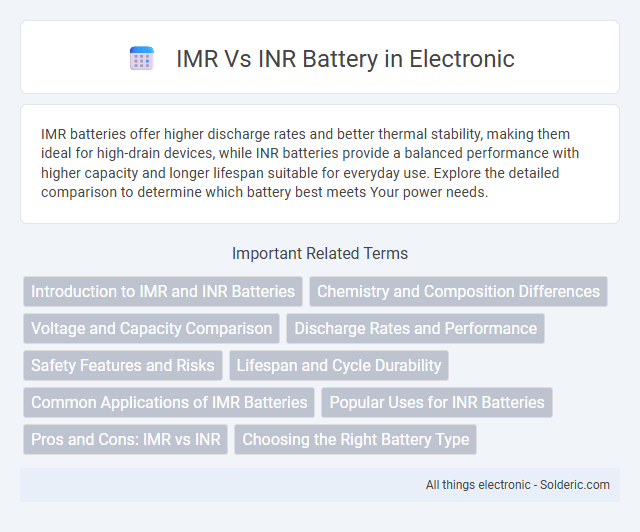IMR batteries offer higher discharge rates and better thermal stability, making them ideal for high-drain devices, while INR batteries provide a balanced performance with higher capacity and longer lifespan suitable for everyday use. Explore the detailed comparison to determine which battery best meets Your power needs.
Comparison Table
| Feature | IMR Battery | INR Battery |
|---|---|---|
| Chemistry | Lithium Manganese Oxide (LiMn2O4) | Lithium Nickel Manganese Cobalt Oxide (LiNiMnCoO2) |
| Safety | High thermal stability, safer under stress | Moderate safety, improved with additives |
| Capacity | Lower capacity, typically 1500-2500 mAh | Higher capacity, typically 2000-3500 mAh |
| Discharge Rate | High continuous discharge, up to 30A or more | Moderate to high discharge, generally 10A-20A |
| Application | High-drain devices like vaporizers, power tools | Balanced power and capacity for e-bikes, laptops |
| Cycle Life | Moderate cycle life, around 300-500 cycles | Higher cycle life, 500+ cycles typical |
| Cost | Generally lower cost | Generally higher cost due to chemistry |
Introduction to IMR and INR Batteries
IMR and INR batteries are popular lithium-ion cells commonly used in high-drain devices such as power tools and vaping equipment. IMR batteries utilize lithium manganese oxide (LiMn2O4) chemistry, offering high discharge rates and enhanced safety by reducing the risk of thermal runaway. INR batteries combine lithium nickel and manganese oxides (LiNiMnCoO2), providing a balanced performance with higher energy density and stable cycle life, making them ideal for applications requiring both power and capacity.
Chemistry and Composition Differences
IMR batteries utilize lithium manganese oxide (LiMn2O4) chemistry, providing high discharge rates and thermal stability due to their spinel crystal structure, which enhances safety and energy efficiency. INR batteries combine lithium nickel manganese cobalt oxide (LiNiMnCoO2) chemistry, balancing high capacity, longevity, and thermal stability by optimizing the ratios of nickel, manganese, and cobalt. The distinct chemical compositions directly influence the batteries' performance in terms of energy density, cycle life, and thermal management capabilities.
Voltage and Capacity Comparison
IMR batteries typically provide a nominal voltage of 3.7V with high current output capabilities but often have lower capacity, ranging between 1500mAh and 3000mAh. INR batteries also deliver a nominal voltage of 3.7V but generally offer higher capacity, frequently exceeding 3000mAh, making them ideal for longer-lasting energy supply. Voltage stability under load is typically better in IMR batteries due to their chemistry, whereas INR cells balance capacity and discharge performance for various applications.
Discharge Rates and Performance
IMR batteries feature higher discharge rates, often exceeding 20A, making them ideal for high-drain devices requiring rapid energy delivery. INR batteries balance discharge performance and capacity, typically offering moderate continuous discharge rates around 10A to 15A while maintaining longer runtimes. Your choice between IMR and INR cells should depend on whether your device prioritizes peak power output or sustained energy efficiency.
Safety Features and Risks
IMR batteries utilize lithium manganese oxide chemistry, offering enhanced thermal stability and reduced risk of thermal runaway compared to INR batteries, which incorporate nickel manganese cobalt oxide and can generate higher energy density but with increased overheating hazards. Safety features of IMR batteries include improved resistance to overcharging and short-circuiting, minimizing explosion risks prevalent in some INR cells during high-drain applications. Despite these advantages, both battery types require proper handling and compatible chargers to mitigate risks such as leakage, venting, and combustion, making adherence to manufacturer guidelines critical for safe use.
Lifespan and Cycle Durability
IMR batteries typically offer superior cycle durability compared to INR batteries due to their manganese oxide chemistry, which provides better thermal stability and depth of discharge tolerance. INR batteries, combining lithium nickel manganese cobalt oxide, often deliver a longer overall lifespan with a balance of energy density and safety features. Choosing between IMR and INR batteries depends on the specific application requirements for longevity and cycling performance.
Common Applications of IMR Batteries
IMR batteries are commonly used in high-drain devices such as vaping mods, power tools, and flashlights due to their high discharge rates and enhanced safety features. Unlike INR batteries, IMR cells deliver consistent power output without the risk of thermal runaway, making them ideal for devices requiring rapid bursts of energy. Your choice of IMR batteries ensures reliable performance in demanding applications where safety and efficiency are essential.
Popular Uses for INR Batteries
INR batteries are widely utilized in electric vehicles, power tools, and high-drain devices due to their high energy density and enhanced thermal stability. Their chemistry allows for improved safety and longer cycle life, making them ideal for applications requiring consistent power output and reliability. The balance between capacity and discharge rate in INR batteries supports demanding tasks such as vaping devices and portable electronics.
Pros and Cons: IMR vs INR
IMR batteries offer higher safety and thermal stability due to their manganese spinel chemistry but typically have lower energy density compared to INR batteries, which combine nickel, manganese, and cobalt for enhanced capacity and longer cycle life. INR batteries excel in performance with better energy output and durability but may pose a slightly increased risk of thermal runaway under extreme conditions. Choosing between IMR and INR batteries depends on prioritizing either safety and longevity (IMR) or higher energy density and performance (INR).
Choosing the Right Battery Type
Selecting the right battery type between IMR and INR depends on application requirements such as discharge rate, capacity, and safety. IMR batteries typically feature a manganese oxide chemistry offering high current delivery and enhanced thermal stability, ideal for high-drain devices like vaping or power tools. INR batteries combine nickel cobalt aluminum oxide, providing higher energy density and longer run times, making them suitable for devices requiring steady power output and extended use.
IMR vs INR battery Infographic

 solderic.com
solderic.com